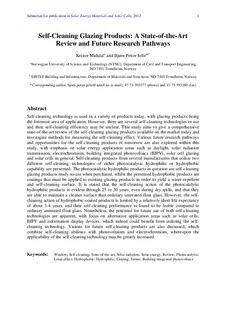| dc.description.abstract | Self-cleaning technology is used in a variety of products to day, with glazing products being the foremost area of application. However, ther e are several self-cleaning technologies in use and their self-cleaning efficiency may be unclear. This study aims to give a comprehensive state-of-the-art review of the self-cleaning glazing products available on the market today and investigate methods for measuring the self-cleaning effect. Various future research pathways and opportunities for the self-cleaning products of tomorrow are also explored within this study, with emphasis on solar energy application areas such as daylight, solar radiation transmission, electrochromism, building integrated photovoltaics (BIPV) , solar cell glazing and solar cells in general. Self-cleaning products fr om several manufacturers that utilize two different self-cleaning technologies of either photocatalytic hydrophilic or hydrophobic capability are presented. The photocatalytic hydrophilic products in question are self-cleaning glazing products ready-to-use when purchase d, whilst the presented hydrophobic products are coatings that must be applied to existing glazing products in order to yield a water-repellent and self-cleaning surface. It is stated that the self-cleaning action of the photocatalytic hydrophilic products is evident through 25 to 30 y ears, even during dry spills, and that they are able to maintain a cleaner surface than ordinary untreated float glass. However, the self- cleaning action of hydrophobic-coated products is limited by a relatively short life expectancy of about 3-4 years, and their self-cleaning performance is found to be feeble compared to ordinary untreated float glass. Nonetheless, the potential for future use of both self-cleaning technologies are apparent, with focus on alternative application areas such as solar cells, BIPV and information display devices, which indeed could benefit from utilizing the self- cleaning technology. Visions for future self-c leaning products are also discussed, which combine self-cleaning abilities with photovoltaism and electrochromism, whereupon the applicability of the self-cleaning technology may be greatly increased. | nb_NO |

